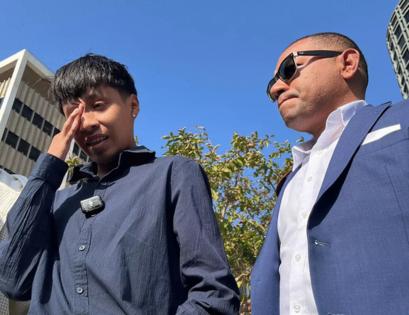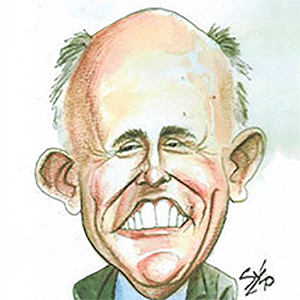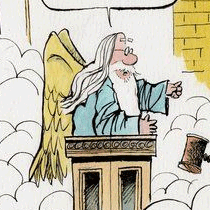Feds say TikToker shot by ICE had previously escaped. A video casts doubt
Published in News & Features
LOS ANGELES — The six armed federal agents loomed around their detained suspect, Carlitos Ricardo Parias, who was handcuffed and sitting on the sidewalk, moaning as he held his right leg.
A small crowd had gathered around them on that day in June, according to video of the incident. Three civilians are seen helping Parias, 44, a well-known TikTok streamer, to his feet and walking him to a car, as Immigration and Customs Enforcement officers and deputy marshals watch. Parias is limping and holding his leg.
“See, they’re not arresting him, they’re not doing nothing,” a woman shouts.
One agent blocks one of the men helping Parias by the car door, but quickly relents. The men then drive away, with Parias still wearing handcuffs on his wrists.
The video of the aborted detention reviewed by the Los Angeles Times contradicts public accounts by Department of Homeland Security officials, who said Parias had “previously escaped from custody.” It raises questions of why the agents appeared to willingly let a suspect go, ultimately setting off a sequence of events that ended in a shooting that wounded Parias and a deputy marshal last week.
The Department of Homeland Security told the Times that Parias is an undocumented immigrant who “had previously escaped from custody,” but did not respond to detailed questions about why six armed federal agents let Parias walk away. A federal criminal complaint charging Parias with assault on a federal officer described him as having previously “avoided capture.”
A spokesperson for the U.S. marshals service declined to comment, referring all questions to DHS.
The June 13 incident became a point of contention during a detention hearing for Parias on Friday morning, with Assistant U.S. Attorney Chris Jones saying that “in the chaos of the scene, and while still in handcuffs, [Parias] picked up and fled.” Gabriela Rivera, Parias’s federal public defender, rejected that claim, arguing that officers “permitted him to go to the hospital” and “had the opportunity and ability to follow up.”
“They waited several months to do that,” Rivera said. “And that’s simply not the conduct someone takes if they think you’re a danger.”
“He was not granted permission by law enforcement to go to the hospital,” Jones countered, saying that Parias had been “whisked away” and had “fled law enforcement twice” in the last several months.
The federal judge ordered Parias released on a $15,000 bond, with an ankle monitor. When Jones asked for a stay of her order until Monday, the judge declined, stating, “I’m not going to leave him in jail over the weekend.”
Policing experts expressed concerns about the June incident.
“None of that looks to me like a guy who is escaping.” said Jim Bueerman, former chief of police of the Redlands Police Department, and founder of Future Policing Institute, an organization that provides research and consulting on law enforcement issues. “It’s more like they’re allowing this or consenting to it.”
The trouble began that day when Parias, outfitted in a “Press” vest, sat in the backseat of a black pickup truck, trailing federal immigration agents.
According to an LAPD report, deputy marshals were assisting ICE with surveillance in the area of Figueroa and W. 48th St. at around 1:45 p.m. As the federal agents drove along W. 48th street, they spotted vehicles following them, police said, including the black pickup truck.
The agents later told police that after the truck blew a red light, they conducted a traffic stop and ordered the driver and front passenger out of the vehicle.
ICE agents said they saw a suspect hiding in the backseat and ordered him out of the truck, according to the report.
The suspect refused to exit and the agents pulled him out, handcuffed him in front and sat him on the curb, police said. Video taken at the scene and shared with the Times shows Parias handcuffed on a curb, groaning in pain.
Police said a large crowd surrounded the agents, video recording their activity. Then, police said two unknown people exited a gray sedan, grabbed the handcuffed suspect from the agents and put him in the back of their car, heading to an unknown location.
In an interview with the Times, the driver of the truck, who declined to be identified fearing legal repercussions, said the agents had exited the vehicle in front of them with assault rifles pointed at them, ordering him and the front passenger to exit the vehicle. He denied running a red light.
The driver said once stopped, they followed the agents’ commands, but acknowledged that Parias was reluctant to exit. He said he saw two agents open the door and drag Parias out of the truck before a third agent helped pin him down. It was then, the driver said, when Parias began to scream out in pain.
“He was yelling out: ‘me están lastimando’ and “me rompieron la rodilla, llamen la ambulancia,’” the driver said. You’re hurting me. They broke my knee, call an ambulance.
The truck driver said the agents didn’t inquire about Parias’ immigration status and never presented a warrant for an arrest.
Federal agents left to avoid conflict with the crowd, according to the LAPD report.
During the detention hearing on Friday, Jones told the judge that, after that day, officers secured an arrest warrant over Parias being in the country illegally.
Rivera described her client as a “citizen journalist” and said that on that June day her client required medical attention “after the way [officers] treated him.”
“Perhaps because of their unlawful use of force against him, officers did not follow up or engage in further enforcement action against him,” Rivera wrote in a court filing.
Policing experts who reviewed video of the incident said the crowd gathering around the arrest on June 13 do not appear to be threatening law enforcement officials, and the federal agents on the ground don’t appear to be taking actions showing that they are concerned for their safety because of the crowd.
“That’s not a violent confrontation,” Bueermann said. “They’re not being overwhelmed by the crowd, and the officers’ body language is not consistent with what I’ve seen where officers are highly concerned for their personal safety.”
Video of the incident doesn’t show agents taking precautions that law enforcement would take if they were concerned with the crowd, Bueermann said, such as setting up a perimeter, or forming a semi-circle to keep control of their suspect while maintaining sight of the crowd.
Instead, Bueermann points out, people in the crowd appear to approach agents, just inches away from Parias while he sits on the sidewalk. When the three men walk to Parias to help him up, none of the agents nearby seem to attempt to immediately stop them.
“This doesn’t make sense,” Bueermann said. “They’re not doing any of that and I cannot tell you that I’ve ever seen a similar situation.”
Teresa Magula of OIR Group, which works with local governments and law enforcement agencies on police reforms, said it could be that agents decided not to make a perimeter, or intervene with Parias leaving, in order to deescalate, but said the crowd doesn’t seem to be aggressive with any of the agents in the field.
But the decision to allow Parias to leave the scene, while still handcuffed, befuddles her.
“It’s wild,” Magula said. “It’s interesting that he’s handcuffed in front of his body as well. That’s not very common procedure for someone you intend to arrest. It also speaks about a lack of control.”
Earlier this week, Parias appeared in handcuffs in federal court to answer to the charge against him. Prosecutors accused him of ramming his car into agents’ vehicles after they boxed him in and ordered him out of the car.
An agent opened fire, wounding Parias and a deputy U.S. marshal, who was hit with a ricochet bullet.
Parias, his left arm in a blue sling, sat mostly quiet, listening to the proceedings through a Spanish interpreter. At times he sighed and looked up at the ceiling, appearing pained. Rivera told the judge her client hadn’t received necessary pain medication for hours.
After conferring with Parias’ 19-year-old son, Rivera asked the judge if the young man could hug his father, whom he hadn’t seen in a week. Citing security concerns, the judge declined to grant the request.
As Parias left the courtroom in shackles his son tearfully shouted out to him in Spanish.
“Pa, vas a estar bien. Estas fuerte, pa,” he said. “Dad, you’re going to be OK. You’re strong.”
-----------
—Times staff writer Libor Jany contributed to this report.
©2025 Los Angeles Times. Visit at latimes.com. Distributed by Tribune Content Agency, LLC.







Comments